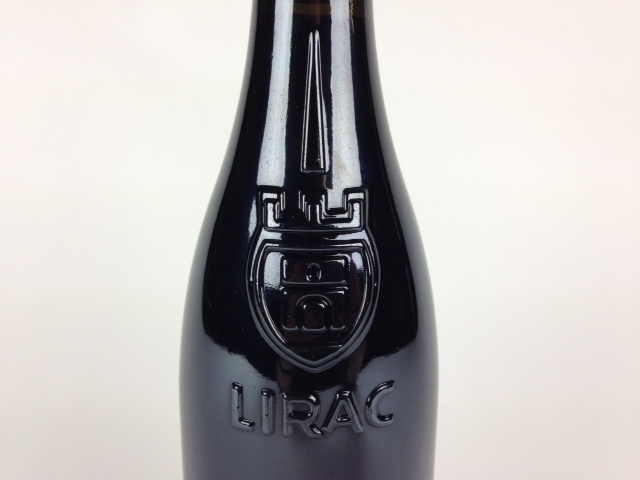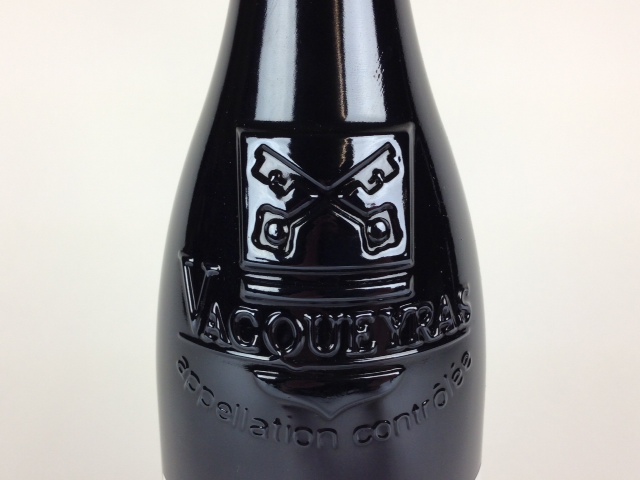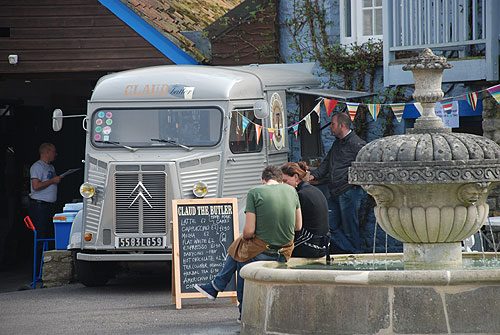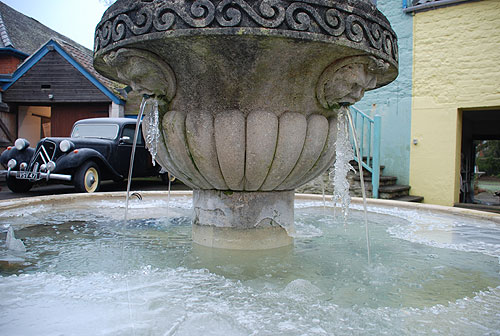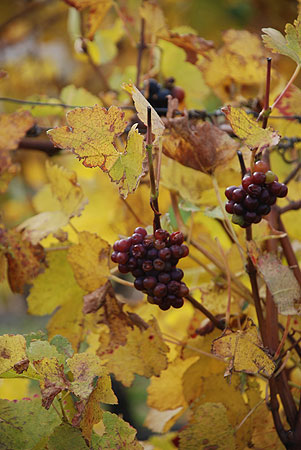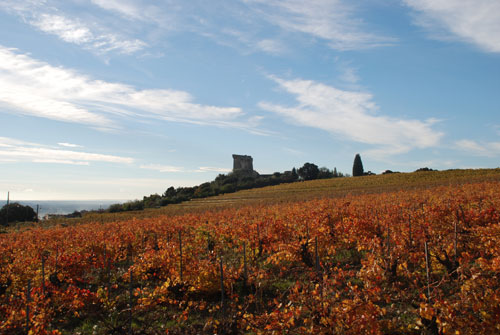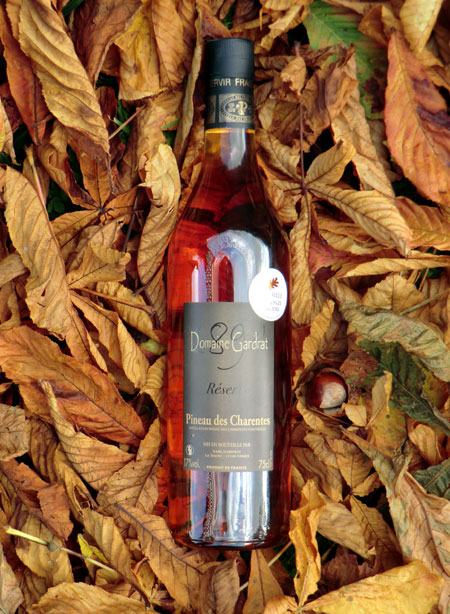
"In the very teeth of winter, Jason and David battle all the way to the wine cellar in search of bottled sunshine; to Châteauneuf-du-Pape, in fact, historical home to the Avignon Popes in exile, a recent ruin, some very big pebbles and thirteen varieties of grape, all of which are permitted into a single bottle of France's finest and first appellation contrôlée wine. First up is a lovely, limpid, 2017 Domaine Du Père Caboche. A relative rarity, only 7% of Châteauneuf' production is given over to white wine and this particular offering has so much fruit, Jason can even taste the wax on the lemons. It wears its 13.5% ABV lightly, too. At last, our plucky pair find themselves warming to a 2016 red from the same estate. Herby and briary with almost fondant tannins, Jason has only to say the word 'daube' and David is transported back in time to Provence and a memorably close encounter with a dish of aubergines. After a brief attempt to out-daube one another, it's time for J. and D. to test the effects of age on a mature C. de P. in the form of a Domaine Saint Gayan's 2011 vintage. Some say that grenache doesn't age well in the bottle, but not so the grapes in this gem of a wine. It would've lain down for another three years or more if only Jason and David hadn't had other plans for it."
Santé,
Jason
The series of 'Adventures in Wine' podcasts featuring Jason Yapp and David Chandler can be downloaded from the iTunes store here.
I was hosting a tasting for WSET diploma students last week and an inquisitive attendee from Korea asked me what the embossed crossed keys on the bottle of 2011 Châteaunueuf-du-Pape from Le Vieux Donjon symbolised. I was able to elucidate with a degree of professionalism that Avignon-based Clement V had been installed as the first of the 'exiled' Popes in 1309 and that his successor John XXII built his summer residence up-river in Châteauneuf' between 1318 and 1333 giving the town both its name and its enduring links with the head of the Catholic church. I knew that the keys of Saint Peter symbol denoted a bottle of authentic château-bottled wine but I did not know that it was the great visionary Baron Pierre Le Roy Boiseaumarié himself, creator of the seminal Appellation Contrôlée system, who devised the embossed bottle as a way of distinguishing Châteauneuf' from lesser pretenders. You can see it here on the only vintage I have to hand which is older than I am – a bottle of 1964 Chante Cigale but it was actually introduced in 1937 just one year after the appellation originated.
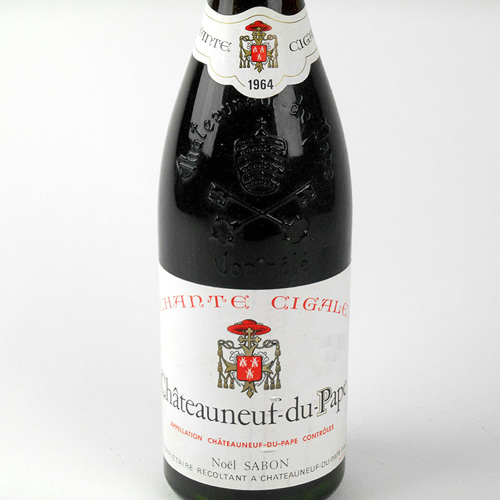
It is said that imitation is the sincerest form of flattery and like many nifty ideas Baron Pierre's raised relief has been ripped-off by all-manner of upstarts.
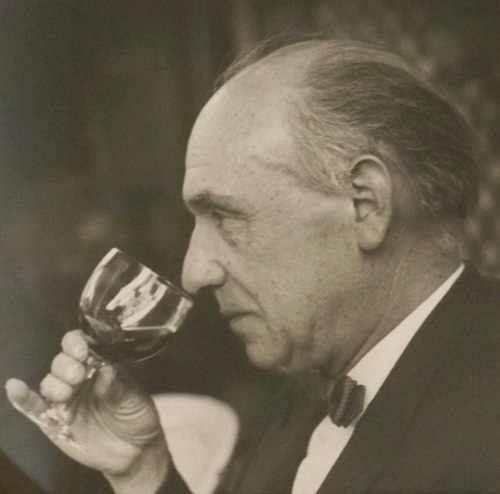
Baron Pierre Le Roy de Boiseaumarié
20 kilometres away in Gigondas they've opted for a shield a hunting horn and some foliage while across the river in Lirac they've got a spikey shield and what appears to be an arc de triomphe - although it might be a Cyclops robot - I'm extemporising here.
The pesky plagiarists of Vacqueyras have gone for a shameless bit of recessed cross key imagery while down in Corsica we get the majestic Moore's head, a scallop shell, Neptune's crown and a couple of Mer-people to boot. Obviously quite a broad brief on that one with understandable nautical leanings.
What really put a fly in the ointment though is that a whole bunch of Châteauneuf' vignerons begrudged paying the subs for their right to deploy the Pontiff's portal-opener imagery and, about a decade ago, introduced the controversial, rival embossed Mitre-bearing bottle. Traditionalists were incandescent and siblings stopped speaking to one another but to this day both symbols vie for supremacy. Personally I prefer the Baron's original emblem but there is plenty of decent wine that ends up in 'pointy hat' bottles.
Not that the Baron was entirely original himself. Are great ideas always inspired rather than freshly forged? As this 1858 bottle of Bouzy illustrates wine-makers were embossing bottle-necks at least 79 years before the syndicateurs of Châteauneuf' staked their claim.
The 2011 Vieux Donjon was unimpeachable by the way. Not a blockbuster but lots of briary garrigue berry fruit and gentle, spicy undertones against a background of supple tannins and cracked black pepper. I am sure the Baron would have approved!
Our founder Robin Yapp is well known for having original ideas and putting them into practice. I wouldn’t say he was impetuous but he certainly has the courage of his convictions and is capable of taking quite a long-range outlook. Thus it was in the early 1970s when he decided our courtyard was lacking a certain je ne sais quoi that he commissioned (at eye watering expense) a replica of the famous fountain in the centre of Châteauneuf-du-Pape - to be hand-carved and installed here in Mere.
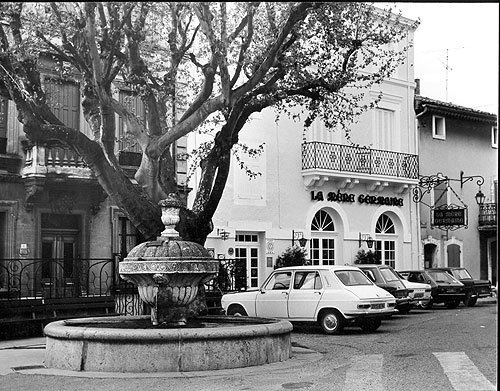
The fountain at Châteauneuf-du-Pape
I remember as a small child quite a bit of fuss and excitement prior to its unveiling and then daubing the dressed stone with natural yogurt to help induce a bit of mould and lichen. Over the years it has brought pleasure to many visitors who like to sit beside its babbling spouts and enjoy a contemplative glass of wine at our café tables. It is now such a centrepiece of our premises that it is hard to imagine life without it.
Unfortunately our winters are harder than those in the Southern Rhône and over the decades we’ve learnt a lot about fountain conservation and the perils of hard frosts on limestone. Happily we’ve stayed on top of the situation and until recently could boast that our jolly folly was in as good as condition as ever.
Last December however, a customer of ours, who shall remain nameless if not shameless, reversed their car into the basin wall of the fountain with such force that the stones fractured and parted.
The result of the impact left more of a ruin than a water feature and after the mandatory calls to stone-masons and insurers we began the long process of restoring the status quo.

Team Jonas in action
Stone carving and setting is a highly-skilled craft and we were thrilled when local stonemason Harry Jonas (www.harryjonas.co.uk), who had helped with repairs 15 years previously, agreed to undertake the job. Harry and his team arrived on site at the beginning of the week and are now putting the finishing touches to a pain-staking restoration.
To use an analogy that Robin might relate to it looks as if our courtyard has had its broken teeth fixed and got its smile back. Just in time for us to break out the agapanthus and enjoy a refreshing glass of rosé in the sunshine!
Summer (assuming, of course, we actually get a Summer) is a time for carefree and irreverent imbibing when we can quaff pretty, coral-coloured rosés and aromatic, young Sauvignons en plein air. Salads and picnic foods cry out for simple, supple wines. Nobody wants to drink anything too demanding while relaxing in a deckchair – clean un-oaked white wines and lightly-chilled reds are the order of the day. However, as Autumn approaches and temperatures cool, ones’ taste buds turn to weightier offerings. Bring on the dense, brooding reds and rich, complex whites that make for fulfilling fireside drinking.
One of nature's compensations for Summer’s end is the wealth of exciting seasonal foodstuffs that become available. Game alone is a reason for wine-lovers to be cheerful as it is the perfect vehicle for bold, muscular, tannic, chest-thumping reds such as Cornas, Irouléguy and Madiran. Just the contemplation of roast pheasant or jugged venison accompanied by a glass of opaque, dark wine with beaded bubbles winking at the brim can have me longing for the first frosts, the scent of wood-smoke and the inimitable sense of well-being imbued by hunkering down beside your own hearth.
Wild mushrooms are another cause for celebration (not to mention ceps and truffles) although the explosion in the popularity of foraging means that competition can be stiff. Apparently demand for wild provender from restaurants is such that gangs of professional fungi finders are fighting turf wars in the New Forest.
There is something about the earthy, elemental qualities of uncultivated mushrooms that marries particularly harmoniously with the tertiary, ‘forest floor’ (the French sous-bois sounds more inviting - if pretentious) scents and flavours of a ‘meaty’ red wine that is beginning to benefit from bottle-age. 80% of wine sold in the U.K. is consumed within 24 hours of purchase, which a depressing statistic as even quite humble wines like Côtes du Rhône Villages and Petit Châteaux Bordeaux can benefit enormously from being cellared for a year or two. As a wine ages its tannins soften and sweeten and a more complex spectrum of tastes evolves. Savvy wine-buyers should be purchasing wines for drinking next Winter or thereafter right now.
Another culinary delight heralded by the onset of Autumn is the availability of the milk-rich mountain cheeses the king of which is Vacherin Mont d’Or, which is traditionally wrapped in spruce bark and can be baked and served warm as a ready-made fondue. Opinions vary as to what wine should accompany this delicacy but an intense and slightly-oxidative Vin Jaune from the Jura or a rich and spicy Gewürztraminer from Alsace would both feature on my short list.
For me the drink that really encapsulates the turning of the seasons and exudes mellow fruitfulness like no other is Pineau de Charentes – a heady blend of Cognac and grape juice that can be sipped chilled as an aperitif or enjoyed at ambient temperature as a decadent bonne bouche. The Louis Roederer wine columnist of the year Victoria Moore fell for our Pineau Reserve bottling from Domaine Gardrat: "This one is stunning. It feels like a caress and when you take a sip is so good that you stop talking. It tastes gloriously mellow, of plump, alcohol-soaked raisins, of prunes, walnuts and the smell of freshly ground coffee, of preparing for Christmas but also of late summer sun." It is not cheap at £19.25 per bottle but, as with most things in life, you get what you pay for.
(This article by Jason Yapp first appeared in Country Calling).
We’ve been hosting Autumn wine tastings for the Oxford and Cambridge colleges for many moons. On my very first venture to Oxford 10 years ago with Robin (Yapp), no sooner had we set up the tasting in preparation for the arrival of the dons than he rushed me off to the Covered Market to seek out the excellent gamebutchers, Hedges. Our business there concluded, we hot-footed it back towards Wadham for 11.30 with a brief detour via The White Horse in Broad Street for a couple of pre-tasting pints of Greene King IPA. As an introduction in how to approach a wine tasting at this fine seat of learning, it took some beating.
So as the temperature dropped at the end of September and our green and pleasant land exploded in vivid russet and orange, my thoughts invariably turned to Messrs Hedges and the Covered Market. This year, I plumped for a couple of grouse, a brace of pheasants and multiple partridge. “You like game, then?” Hedges Junior enquired, unnecessarily I have to say. Back at the tasting, via a coffee shop rather than The White Horse (in case my wife reads this), I had my eye on several bottles that I thought might not get consumed during the duration. This is a discreet perk of all wine tastings, how else can one afford to drink on the wages of this industry? So my grouse was preceded by white Chateauneuf-du-Pape Vieux Donjon 2008 and perfectly accompanied by Cornas Clape 2006.
There are few wine tasting venues that can match the regal splendour of Vintners’ Hall in the City of London and we are inordinately grateful to the Vintners’ Company for allowing us to visit periodically. Bedecked in oak panelling and dazzling with silverware amassed over 6 centuries this is a great setting for a wine tasting especially when the wine makers themselves are present.
On Monday evening last week 6 of our long-serving (possibly long-suffering) suppliers joined us in London to show off their wares.
Laurent Bunan, from Domaines Bunan in Bandol, was showing off his superb white and rosé wines which are little-known on these shores but are hugely popular on the terraces of the Côte d’Azur; where they make an ideal accompaniment to freshly caught seafood. Laurent also exhibited a brace of Mourvèdre-based reds. The Mas de la Rouvière 2004 is beginning to soften with bottle-age and is packed with briary, hedgerow fruit that puts one in mind of warming stews and braises. Laurent’s flagship ‘Cuvée Charriage’ is a belting great blockbuster – approachable now, if decanted, but a wine that will mature well over a further 5 years.
At the neighbouring table Christine Campedieu was dispensing samples of her inimitable Collioure. Her white ‘Les Canadells’ is blended from 70% Grenache Gris and 15% each of Grenache Blanc and Macabeau. It is slightly resinous with wild herb notes and a long, elegant finish – enough to transport one to the Catalonian coast at sunset as the waves lap against the shore... Christine’s red wines named ‘La Pinède’ and ‘Puig Oriol’, after the vine plots, are blended from Grenache mixed with Carignan and Syrah respectively. Both have a strong sense of terroir and a fine concentration of fruit. I thought the ‘La Pinède’ was the slightly more forward drinking of the two but if I can convince ‘her indoors’ that the kids don’t need new winter coats I might invest in both for the Cave Personelle. Not to be overlooked is Christine’s seductive, sweet, dark Banyuls Réserva. It is infused with complex raisin and fig flavours and is one of very few wines that can cope well with chocolate – or Christmas pudding for that matter.
Patricia and Olivier Luneau met at wine school in Beaune and honed their craft in New Zealand. They run a forward-thinking vineyard in Mentou Salon producing fruit-accentuated wines of enormous charm. Simon Hoggart recently described their Menetou Salon Rosé wine in the Guardian as being: “So delicious – fruity and rich and round and yet with a real strength.” Their white wine, made from pure Sauvignon, was also showing very well in the current 2009 vintage. They must have mixed feelings about that as they lost three-quarters of the potential harvest to summer storms - fortunately they’ve generously agreed to uphold our usual allocation. Patricia and Olivier were also exhibiting their delightful red Menetou Salon Pinot Noir that has a bright berry-scented bouquet and a savoury palate of ripe red fruit and supple tannins. It would make a splendid partner to a plate of charcuterie or crusty bread and a good coarse pâté.
Bruno Ribière, who has the privilege of working with small parcels of ancient vines in the Roussillon, drew quite a crowd with his characterful range of wines that are incredibly evocative of their sun-kissed locale. Encouragingly, Master of Wine (and aide-de-camp to Jancis Robinson OBE) Julia Harding even put in a personal order for some of Bruno’s dry white Catalan Grenache. It is highly distinctive with an almost sherry-like palate and a long, mineral-edged finish. Bruno is equally well known for his dark, earthy, reds as testified to by a trio comprised of a brooding Carignan (from 130 year-old vines), a rugged Côtes du Roussillion ‘Cuvée Tradition’ and his dense, age-worthy ‘Cuvée Cana’.
Our only ‘no show’ of the evening was young Nathalie Margan from Château la Canorgue on the Montagne de Luberon. Sadly Nathalie was laid low by a virus on the eve of our tasting and was unable to join us. Fortunately her wines spoke for themselves and were well received in her absence. Château la Canorgue has pioneered organic viticulture since Nathalie’s father Jean-Pierre first set up here in 1978. Their white Côtes du Luberon, blended from Rhône staples Grenache, Clairette, Roussanne and Marsanne is grown at quite a high elevation and is fresher and zestier than most. Their delicious coral-pink Luberon rosé wine (from a blend of Grenache, Cinsault and Syrah) is also clean, crisp and palate cleansing – it works well with or without food. An intriguing Vin de Pays called ‘Béret Frog’, made from (almost) pure Syrah (with a notional dash of Grenache) drew the attention of veteran wine scribe Malcolm Gluck who observed: ‘Plump yet very gripping tannins provide solid buttressing to svelte, mellow fruit.’ The more senior Château la Canorgue red (40% Syrah, 30% Grenache and 30% Carignan) has more complexity and length but reflects the same diligence and skill in the cellar and will be drinking well this winter.
Last but by no means least we were delighted to welcome Emilie Boisson from the acclaimed Domaine du Père Caboche in Châteauneuf-du-Pape. Emilie and her father Jean-Pierre (who is serving his third term as mayor of the town) produce a fresh, racy, consistently pleasing white Châteauneuf-du-Pape from a blend of 40% Roussanne and 20% each of Grenache Blanc, Bourboulenc and Clairette. It is vinified in stainless steel and the malolactic fermentation is blocked by a combination of chilling and filtration. It is one of few whites from the appellation that is zesty enough to be drunk comme aperitif and is a personal favourite. The Boissons, however, are best known for their Grenache-based red wines that have been described variously as ‘sexy’, ‘seductive’, ‘hedonistic’ and ‘voluptuous’ (you get the idea) by no lesser personage than Robert Parker. The entry level ‘Petit Caboche’ is a cracking Vin de Pays, packed with red berry flavours over supple ripe tannins. It is a failsafe ‘crowd-pleaser’ for dinner parties and people suffering withdrawal symptoms from Downton Abbey. ‘Château la Côte’ is a precocious, (new to us) fruit-accentuated Côtes du Rhône Villages in the awesome 2009 vintage that proved very popular on the night and is a shoo-in for our next annual list. 2007 was a historic vintage in Châteauneuf’ so it was a treat to taste the Domaine du Père Caboche red which is drinking really well right now with a lovely warming palate of black berries and cherries and subtle briary undertones. I managed to cajole a swan-song 100 magnums from Emilie when she was still on a post tasting high - if you’re wondering what to drink this Christmas you could do far worse. Finally we finished the evening sampling the flagship ‘Cuvée Elisabeth Chambellan’ again in the magnificent 2007 vintage. It is deeper and darker than the ‘regular’ bottling and comes from 100 year-old vines on La Crau plateau. It made for a terrific finale to a wonderful evening. The general consensus from all parties being that we should do that more often!
It’s our final day in the Rhône valley and we are beginning to flag a little as we wend our way out of Orange once again at 8.30am. We’ve long since given up trying to convince friends and family that tasting wine is an arduous task, but you can have too much of a good thing. We are now well into three figures for wines tasted and considered this week for our Rhône 2009 vintage report, so we are both looking forward to getting back home. Yet it’s hard to feel sorry for ourselves as we roll up at Domaine Saint Gayan in 20 degree sunshine. Its 9am and Mont Ventoux towers above us in a blue sky, beautiful but brutal, and Jean-Pierre Meffre takes us through his gamme covering Sablet, Rasteau, Gigondas and Châteauneuf-du-Pape (where he owns less than a hectare that abuts the vineyards of Beaucastel). We taste a succession of vintages and its clear that the 2009's will have a freshness and elegance by comparison with their beefier 2007 siblings.
Heading north (on the home stretch now) we arrive at Domaine Biguet just outside Saint Péray, west of Valence. We’re an hour late for our tasting but Jean-Louis Thiers remains relaxed and promptly shows us in to his neat tasting room. Saint Péray is commonly recognised for its sparkling wines that historically out-priced Champagne, but the still version (also made from 100% Marsanne) deserves to be better known, with aromas of orchard fruit and a ripe, rich palate.
Our final tasting en route to Lyon airport is fittingly at Domaine Georges Vernay in Condrieu. Here we taste the range of 2009 Viogniers for which the estate is justifiably world-renowned, as well as red Côtes du Rhône (interestingly from vines within the AOC limits of Condrieu) and a sleek St Joseph from 35 year old vines. Paul Amsellem (Christine Vernay’s husband) is gamely hosting a large party of Norwegians, so winemaker Christine conducts our tasting and the conversation flows from yields and lieu-dits to the ‘dematerialisation’ of the music industry.
Alas, we have to flee as our return flight beckons, but it’s been one hell of a week!
Jason & Tom.
Fortified by a superb dinner at Guy Julien’s truffle-orientated restaurant ‘Le Beaugravière’ in Montdragon (which has a legendary Rhône wine list) we arrived in Châteauneuf-du-Pape on Wednesday morning greeted by a blue sky and southern sunshine.
At Le Vieux Donjon Marie-José Michel and her daughter Claire gave us a warm welcome and the happy news that the Rhône 2009 vintage had surpassed their expectations. We then sampled a bottle of their excellent white Châteauneuf’ 2009. Made from equal volumes of Clairette and Roussanne this mid-weight, un-oaked offering has subtle citrus and ‘fleurs blanches’ scents and a bright, palate of white orchard fruit underscored by a clean acidity. It is drinking wonderfully well right now and should continue to do so for a further 3 years. Claire then produced a cask sample of the red Le Vieux Donjon 2009 which exhibited a powerful bouquet of red fruit and a complex palate infused with garrigue berry and Provençal herb notes. We then compared with a bottle of the blockbuster 2007 vintage (which still has plenty of youthful vigour) and although the 2009 is a shade lighter and less concentrated (dare we say more feminine?) it is clearly a superb and age-worthy wine.
Down the road at Domaine du Père Caboche another young vigneronne, Emile Boisson, was equally upbeat about the 2009 vintage. The Boisson family is renowned for producing forward-drinking, fruit accentuated wines for immediate gratification. Their white Châteauneuf-du-Pape 2009 is a classic with a fresh, sapid palate and attractive white peach aromas. It is cleaner and zestier than most of its peers and you could happily drink it as an aperitif. The principal cuvée of red Châteauneuf’, called simply ‘Domaine du Père Caboche’, has a bright bouquet of crushed red berries and a supple, silky palate of warming red fruit flavours and ripe, sweet tannins. This is a wine for shameless hedonistic consumption while waiting for grander, more contemplative wines to mature. The Boissons’ flagship wine called ‘Elisabeth Chambellan’, from 100 year-old vines on ‘La Crau’ plateau, is deeper, darker, richer and more complex than the regular bottling but it retains the domaine’s signature of seductive, come-hither fruit. It will age well for a decade – if you’ve got the patience to wait that long.
Having completed our tastings in Châteauneuf’ we then headed south to Les Baux to sample the wines of Domaine de Trévallon. Strictly speaking this is in Provence and not the Rhône valley but it’s certainly a wine that appeals to Rhône enthusiasts so we were keen to pay a visit. After successfully negotiating the backwaters of Les Alpilles we were greeted by Antoine Dürrbach and his younger sister Ostiane who are both now firmly involved in the family business. We kicked-off with a tasting of the rare and idiosyncratic white Domaine de Trévallon 2009. Made from a unique blend of Marsanne (45%), Roussanne (45%), Chardonnay (7%) and Grenache Blanc (3%) raised in oak barrels (half of which are new) this is rich, powerful, gastronomic wine that probably requires a bit of bottle-age and a food accompaniment to be seen at its best. We then sampled the 2009 red Syrah from barrel which had an impressive purple colour and a core of concentrated sweet, black fruit over fine-grained tannins. We then tasted the Cabernet Sauvignon which had a lovely cassis bouquet, very bright fruit and a fresh acidity. The obvious thing to next was to sample a blend of the two together which produced a really harmonious result – a great balance of berry aromas, ripe fruit, sweet tannin and clean acidity. Considering its southern location Domaine de Trévallon is a very vintage sensitive wine and it appears that the 2009 is going to be a classic. As in Châteauneuf-du-Pape some of the raw power of the 2007’s might be missing but there is great balance and purity which will yield a wine of elegance and enormous future gratification.
After another day spent tasting young Rhône wines there is really only one choice of liquid refreshment – a cold demi pression or two in ‘Le Mistral’ bar in Orange.
Jason & Tom.
(Continuing the voyage down the Rhône valley this week, to catch up with vigneron friends and get an insight into the Rhône 2009 vintage).
Domaine Jean-Louis Chave is a key reference point for the entire Rhône valley, and securing an audience with Jean-Louis himself is never easy. Space precludes going into too much detail here, but the red Chave Hermitage 2009 has the potential to be a legendary wine and on the strength of our cask tasting I would be surprised if Jean-Louis did not produce a bottling of his prized Cuvée Cathelin. All of the components that are required for a classic, age-worthy red Hermitage are here – a wealth of dark fruit flavours and well-structured tannins underscored by a fine acidity. The finished wine won’t hit these shores until Spring 2012, but it will be worth the wait. Not to be overlooked is the Chave’s peerless white Hermitage which should also be ‘bien classique’ in this impressive vintage.
Just South of Tain l’Hermitage, at Les Chenes Verts, young Maxime Graillot exudes confidence at the purpose-built winery he shares with his semi-retired father Alain. Their red Crozes Hermitage is juicy and fruity and will provide rewarding drinking from the off. A new negoçiant cuvée of Cornas called ‘Equis’ was hugely impressive with a core of dark Cassis fruit over a foundation of ripe, subtle tannins. We wound up a great day’s tasting with the Graillots’ fresh, youthful white Crozes (20% Marsanne / 80% Roussanne) already bottled under screw cap and selling rapidly.
Tomorrow we head south for Châteauneuf-du-Pape to see if the wines of the Cotes-du-Rhone Meridional can compete with their cousins in the North.
À demain (hotel wi-fi permitting),
Jason & Tom
There is a widely held belief that while the red wines of the Northern Rhône will age almost indefinitely the reds of the South don't make old bones. This is a bit of a generalisation and, of course, is rather vintage dependent but it is true that by and large the Syrahs of the Northern Rhône do live longer than their Grenache-based counterparts in the Côtes du Rhône Méridionale.
Last Saturday evening 'Team Yapp' and significant others gathered for a barbecue to celebrate our 40th anniversary in the trade and it was with some trepidation that I broached our last remaining case of Châteauneuf du Pape from Domaine Chânte Cigale in the 1969 vintage. 1969 was a pretty decent year for Châteauneuf-du-Pape but given that the great Rhône guru John Livingstone-Learmonth (www.drinkrhone.com) wrote in his 1992 edition of 'Wines of the Rhône' - "These wines need drinking forthwith."
I wasn't holding out too much hope for this wine. On the positive side provenance counts for a lot and this wine hadn't moved from our cellars since it was first shipped sometime in the early 1970s. Despite a little bit of ullage the pale green, lead capsuled bottles, still in their original purple tissue paper had respectable levels which augured well. Upon opening things didn't look so great as the wine was a pale rusty colour and had thrown a lot of fine sediment. A first tasting (pre-decanting) confirmed my worst fears - this appeared to be a wine that was well past its prime - both closed on the nose and thin on the palate. Happily my fears were ill-founded, after careful decanting and an hour's resting time this damp squib had transformed into a fire-cracker. Over 20 people tasted this blind and almost everyone assumed it was a much younger wine and it met with unanimous approval. The bouquet had developed attractive stewed-berry and sous bois aromas and the palate had a core of sweet cassis fruit and a fine elegant finish.
40 years is a lot to ask of a Châteauneuf' even in a superior vintage but if they are carefully cellared they can last for decades. I must try and keep some of the excellent 2007s on one side for my 80th birthday celebrations in 2047.



